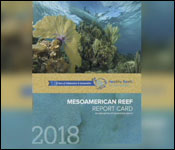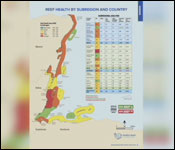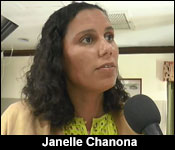

After 2 years the conservation community has put together the latest Reef Report Card. It’s the annual assessment of the entire Mesoamerican Barrier Reef System - which passes through Mexico, Belize, Guatemala and Honduras.Â
To measure the comparative health of the entire system, marine biologists have sampled 319 different sites along the reef, looking for indicators of a healthy reef system.
After collecting all that data, they can then determine which part of the reef system has improved, and which parts are in danger.
Well, this year’s report card is ready, and according to the experts, at this point, Belize’s reef is healthier than it was 10 years ago. It has been upgraded from poor to fair. So, we start with the good news, which was underscored by the Vice President of Oceana Belize, Janelle Chanona:

Janelle Chanona - VP, Oceana Belize
"I think, over all, when you look at the long term, the 10 year picture, that we've been moved from the poor to fair category is something to make note of. But, if you think of your mom reading your report card, and your teacher is saying, 'Daniel can do Better', Belize can do better. I think that's the take away home message from this report card, that Belize can do better, and we're shaping up to do that. I think think the oil legislation puts us on the right footing."
So, from there, we look at the national picture of the reef, when compared to the efforts of the other 3 neighboring countries, which are responsible for their portion of the reef system. Here are the comparative statistics and the breakdown by Dr. Melanie McField:

Dr. Melanie McField - Executive Director, Healthy Reefs Initiative
"If we wanna compare ourselves a little bit on the national scale. So, we're kind of zooming up some. We can look at Belize. Again, we are tied for second with Mexico. It's the same score. Honduras has a 3.0, and Guatemala had the lowest score of a 2. So, this again - the reef health index, taking those 4 indicators, and you just average the numbers. Each of the indicators could get a number, 1 through 4, based on the value, how good it was. So, it's interesting. You can see like Honduras has the most herbivorous fish, but yet still has the highest abundance of macro-algae. So, that is telling me that really, they've got a lot of nutrient inputs. They need more herbivores. It's not just about the fish. I'm also gonna talk about that later. It's also about the sea urchins, and other herbivores that are out there. But, you can see that okay, so Belize and Mexico look very similar, and Guatemala has a serious problem with their fish populations. They, at the moment, don't have any fully protected. This score, the 2.8 is actually the same score we got 2 years ago, for the overall region. So, with that, we've kind of held our own, in terms of reef condition. But, when you compare back - since this is a decade of data that we're looking back on, since 2006, it has gone up from 2.3. So, over that decade, we have improved, but in the last 2 years, the overall regional grade has stayed the same. And we look across the whole region, we can see that there were 3 sub-regions that were ranked as good, Cozumel, Southern Belize Barrier, and Nutilla. So, that's really good. We wish we had more of them, but on a whole, those entire sub-regions had enough good sites that it was ranked, on average, they were classified as good."
But, while Belize’s portion of the reef has improved, there is a lot more work can be done to improve its health. Dr. McField revealed that the central region of the reef, meaning the portion sitting in front of the Belize District, and which runs all the way down to the coast of the Stann Creek District has deteriorated from poor to the worst condition:
Dr. Melanie McField - Executive Director, Healthy Reefs Initiative
"I pulled out this little information in the white box about Belize because what you can see is this 12% good, that increased from 4% in the last report card. So, that's a really good thing, and it came from the poor, the amount of reefs that were classified as poor has decreased. The amount classified as good, increased, and the others stayed about the same. So, that's really the big picture, in terms of all these sights, we had 94 sites in Belize, and that is good amount. So, it's a very stable and consistent number of reef sites that we've been monitoring over the years. The bad news in terms of Belize is that one big red splosh right in the middle, central barrier reef, that is new. Last year, it was ranked as poor - last 2 years ago, it was ranked as poor, and now, it's actually ranked as critical, mostly due to the lack of fish. We know that this central region of Belize has - we don't know how many, but we know that there are a lot of fish traps out there. And so, I'm encouraging you that work in that region, and have ongoing projects, to try to help come up with a plan to census these things. We need to know how many are out there. I'd like to see more pictures of them out in the sea, what's in them, because we know that parrot fish, that protected species that is supposed to be reducing the macroalgae, and helping to protect the reef, they love to go into fish traps. So, they must be in there, and another piece of evidence we have from the central statistics office. They track all the exports of the country, and whole fish exports have been pretty stable. Normally, it is around 400,000 to 450,000 pounds per year being exported out of the the country. For some reason, in 2015, there was 1.1 million pounds exported."
So, what should Belize be doing to reverse the damage on this portion the reef that is sitting in Belizean waters? Well, that’s what we asked the expert at the end of report card launch. Here’s what she told us:
Dr. Melanie McField - Executive Director, Healthy Reefs Initiative
"The critical ranking for that central barrier reef sub region, the whole region ranked as critical for the first time, and that was largely due to the very low abundance of fish. Both commericial fish, and herbivorous fish, are extremely low in that region. Our data don't tell us why that is, but we were discussing ti among the other NGO's that work in the region, and we think that fish traps are a big part of the problem. And we went and looked at the export data for the last few years, and we've seen that there was a huge spike in exports of whole fish in 2015, from like 450,000 pounds, which was normal for the country's export for the year, up to 1.1 million. So, a lot of more fish went out. We don't know that it all came from that region. We can't say for sure, but that is our speculation as to where the fish went."
Daniel Ortiz
"So, is it a concern of overfishing, per say, or just detrimental fish gear?"

Dr. Melanie McField
"I think it's a little of both, because in that central zone, you also don't have as much fully protected areas. So, there's one marine protected area. That's the Southwater Caye Marine Reserve. It's very big, and it has some no take zones, but that is not very well enforced. So, it's just a big area, and they haven't gotten the level of budget that they need to really do a good job managing that. So, we don't see an increase. So, if there is no way to re-seed that region - we need to have big fish reproducing to re-populate, and that region has less of that than anywhere else."
Only 94 of the 319 test sites are in Belize’s waters. |

